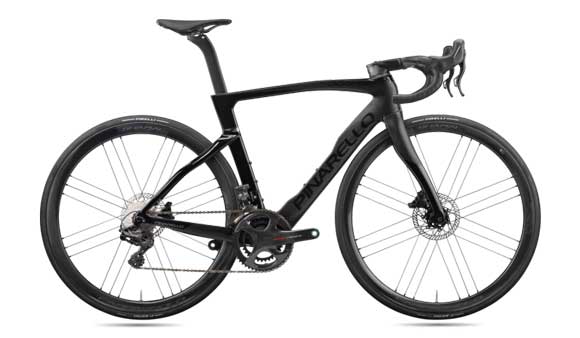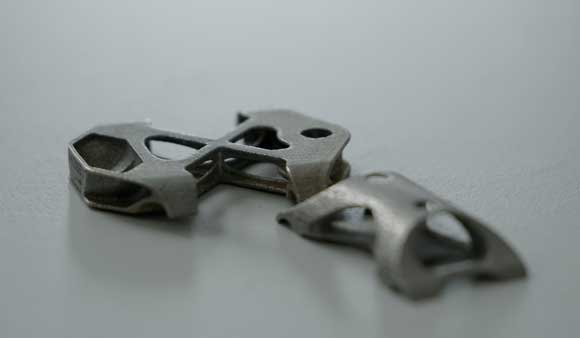Pinarello selects Materialise’s metal AM solutions for production of its lightest racing bike
July 19, 2021

Racing bike specialist Pinarello, headquartered in Villorba, Italy, recently unveiled its new racing bike, Dogma F, which features metal additively manufactured components produced by Materialise, Leuven, Belgium. The use of Additive Manufacturing helped the new racing bike to be significantly lighter – almost cutting the weight of a crucial seat component in half – and enabled the design and production of 2,000 parts in just three weeks.
More than just weight reduction
With weight being a crucial factor in the cycling industry, Pinarello aimed for a racing bike that weighed less than that of its competitors. However, meeting this goal meant more than just weight reduction: the team needed to balance this with cost, quality, speed of production, and the number of units manufactured.
“The challenge for Pinarello R&D was really to focus on weight reduction,” stated Maurizio Bellin, Chief of Operations at Pinarello. “When cyclists are climbing and sprinting many kilometres against the wind, the lighter the bike, the faster you go. This is why we aimed for the minimum possible weight.”
Pinarello initially collaborated with various suppliers experienced in technologies that promise strong, lightweight results. The company had an original design for its seat clamps that used traditional manufacturing methods, but to achieve the weight results Pinarello strived for, it turned to Materialise and Additive Manufacturing.
The challenge of producing AM parts at scale
The Materialise team knew that metal AM’s design freedom would be capable of producing a significantly lighter seat clamp – the challenge lay in producing the parts at scale within just a few weeks. Materialise’s internal design and engineering, software, and manufacturing teams came together in order to accomplish the production goals.
“In our Metal Competence Center in Bremen, Germany, we have all of the expertise we need under one roof,” explained Philip Buchholz, Technical Project Manager at Materialise. “In these new facilities, we unite our internal design skills, the extensive knowledge of our research and development department, and our industrialized production processes.”
Tim Hermanski, Design Engineer at Materialise, commented, “The design and engineering were done in close collaboration with Pinarello. With each design iteration, we first completed virtual simulation tests. The seat clamp needed to be lightweight, but its purpose requires enough strength to hold the weight of the cyclist. These internal tests saved a lot of time ensuring printability and reliability of the final part.”

Once the tests were complete, the team shared the additively manufactured designs with Pinarello so that the company could conduct its own physical tests, such as fatigue tests on both a test bench and the road.
A major benefit of metal Additive Manufacturing in this case was the speed with which they were able to finalise the design. Whereas conventional manufacturing requires new moulds and complex CNC programming during each design update, this was not the case here. The designs are completely digital and can therefore be adjusted rapidly.
In addition to the actual design of the part, the teams needed to address the challenge of producing a high number of parts in a short time. The project required 2,000 individual parts to be additively manufactured in less than one month. The Materialise team were able to create a full-service, customised production workflow, which included labelling and quality inspection, in order to achieve the goal.
“We had to introduce industrialisation within our production chain,” added Buchholz. “We did so by designing a part and a process that needed no support structures or manual post-processing steps. Eliminating these steps saved us a lot of time during manufacturing. We also created a custom printing parameter set that sped up printing time, met the required material properties, and made the project feasible by optimising costs.”
“We achieved all this with the Materialise Process Tuner — a solution we’re bringing to the market later this year that extensively ‘tunes’ process development,” he continued. “This software not only accelerates the set-up of parameters but also reduces mistakes thanks to automation and provides insights and clever statistics all stored in a centralised database for future operations. We developed optimised printing parameters in a matter of weeks instead of months. We couldn’t have achieved this without the combined know-how of our software and D&E teams at the Metal Competence Center.”
Design optimisation and streamlining production
Through close collaboration with Pinarello, Materialise were able to design the seat clamp in a way that leverages AM’s design freedom to accomplish a significant weight reduction. The titanium component, additively manufactured using Laser Beam Powder Bed Fusion (PBF-LB), was 42.5% lighter than the original aluminium design produced via a traditional production process.

The speed with which Materialise additively manufactured the parts at this scale was also an impressive feat. By optimising the design and streamlining production processes, the team went from order to delivery for 2,000 parts in three weeks. To exemplify this speed, traditional manufacturing requires orders of this size placed between six to twelve months in advance, especially in times when supply chains are impacted by global raw material and production capacity shortages.
Being located in Europe was also said to be a significant advantage in this case. Materialise were able to provide quicker lead times and a more sustainable delivery as opposed to ordering from a manufacturer across the globe.
“Thanks to Materialise and our attention to detail, we saved 35 grams just on the small seat post clamp,” added Bellin. “To put that into perspective, that’s 8 more grams saved than the final weight reduction of the seat post itself. The details make the difference. And thanks to 3D printing, we can really prove that.”
“But it’s not only about the weight savings. With 3D printing’s accessibility, we can offer this technology to more than just the top cyclists competing in the Tour de France. We can offer it to everyone around the world,” he concluded.
















